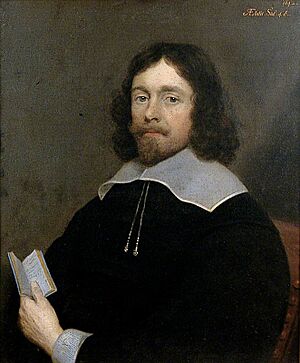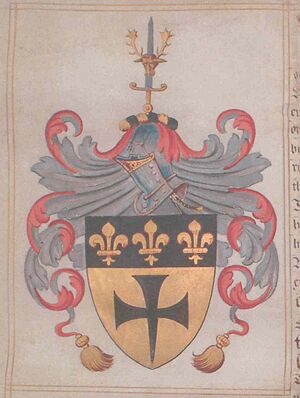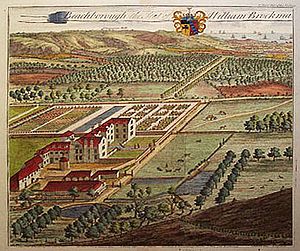Sir William Brockman facts for kids
Sir William Brockman (1595–1654) was an English landowner and a military leader. He is most famous for bravely defending the town of Maidstone during the English Civil War. He fought for the King's side, known as the Royalists, but unfortunately, they did not win the battle.
Contents
Early Life of Sir William
William Brockman was born in 1595 in a place called Lyminge in Kent, England. His parents were Henry Brockman and Helen Sawkins. He went to Oxford University for his education. On May 28, 1616, he married Ann Bunce, who was the only daughter of Dorothy and Simon Bunce. Ann was from Lynsted. William and Ann had seven children, but their first son, Henry, and a daughter sadly died when they were babies. In 1632, King Charles I made William Brockman a knight, so he became known as Sir William.
Fighting in the English Civil War
When the Civil War began, Sir William Brockman stayed loyal to King Charles I and the Royalists. In 1642, the King chose Sir William to be the High Sheriff of Kent. But soon after, he was arrested and put in prison in Winchester Palace in London. This was likely a way to stop important Royalist supporters from helping the King. Sir William was replaced as Sheriff. He stayed in prison until August 1645. From June 1644, he was moved to Westenhanger Castle in Kent because his health was getting worse in the London prison. This castle was only a couple of miles from his home at Beachborough.
In 1648, when the second part of the war started, Sir William finally joined the fighting. He was part of a group led by Sir John Mayney. His group in Maidstone had to fight alone against a large army called the New Model Army. This army was led by Sir Thomas Fairfax.
The Battle for Maidstone
Fairfax marched towards Maidstone with about 6,000 experienced soldiers. The Royalist soldiers in Maidstone were about 1,000 at first. Some of them were sailors, and some were new recruits. Lord Fairfax crossed the river at East Farleigh Bridge and got ready to attack the town. Sir William Brockman managed to bring in about 800 more soldiers to help.
The attack started around seven o'clock in the evening, in heavy rain. The people of Maidstone fought very hard. The battle spread into every street. Royalist soldiers fought from quick barriers they built in the streets and from inside houses. The fight became a house-to-house struggle. The battle continued until midnight, still in the rain. The remaining Royalist soldiers were pushed into a churchyard. They eventually agreed to surrender, and their safety was guaranteed. Fairfax reported that Sir William and other leaders were captured. This was Sir William's second time being imprisoned.
Lord Fairfax's Battle Report
Here is a part of the letter Lord Fairfax sent, explaining his victory at Maidstone:
To the Earl of Manchester, Speaker of the House of Lords,
My Lord,
God has given us a victory against those who started an army without Parliament's permission. I must tell your Lordship about it quickly. The fight began last night, around seven o'clock, near Maidstone. It was a very fierce battle until after midnight before we took control of the town. The enemy kept getting more soldiers from their forces. They fought hard in every street and passage. Their best soldiers were fighting here, and Lord Goring was their General.
About two hundred of the enemy were killed, many were wounded, and about nine hundred were captured. We also took four hundred horses, eight cannons, and many weapons and ammunition. Sir William Brockman and other gentlemen are now prisoners. Since God has given us this victory, I want us to thank Him for it. I will use this advantage as God helps me.
Your Lordship's
Humble Servant,
T. Fairefax.
Maidstone, 2 June, 1648.
Later Life and Family History
Records show that William was still a prisoner in 1651. He, his brother Zouch, and many other Royalists were declared "delinquents." This meant they had to pay large fines. Sir William was fined £500, and Zouch was fined £350. We don't know exactly when William was released from prison this second time.
Even with his time in prison, Sir William managed to keep his family's estate safe. He was able to pass it on to his son after he died in 1654. Sir William was buried on December 6, 1654. His son, James, inherited the estate.
Sir William came from a family that had lived in Kent for a long time. They owned several properties there. Around 1500, William's great-grandfather, Henry Brockman, bought Cheriton Manor, Newington Manor, and Beachborough Manor. Sir William's father was also named Henry. There is a special stone tablet in St Nicholas Church, Newington, that remembers him.
Sir William is important to people today, especially descendants of his relatives who now live in the US and Australia. For example, after the Civil War, his second cousin, Henry Brockman, moved to the American colonies. He started the English branch of the Brockman family in the United States. Later, some of their relatives, through the Drake-Brockman family, moved to Australia. Many of them became important leaders in the military and in their communities.




